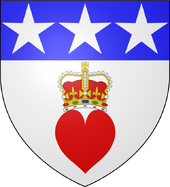| ||||||||||||||
| ||||||||||||||
|
| ||||||||||||||
Clan Douglas, also referred to as The House of Douglas, is an ancient Scottish clan from the Scottish Lowlands taking its name from Douglas, South Lanarkshire, and thence spreading through the Scottish Borderland, Angus, Lothian and beyond. The clan does not currently have a chief, therefore it is considered an armigerous clan.
The Douglases were once the most powerful family in Scotland. The powerful Douglas chiefs held the titles of the Earl of Douglas (Black Douglases), Earl of Angus (Red Douglases) and later, Earl of Morton.[2]
Many Douglases married into Scottish and other European royal and noble houses, thereby ensuring Douglas power within Scotland, as a result of their accummulated wealth.
The family's original seat was Douglas Castle in Lanarkshire, but they spread to many properties throughout Scotland.[3]
History[]
Origins of the clan[]
According to tradition the Douglases took their name from the Cumbric or Gaelic placename "Dubh glas" meaning "black blue/green stream". One old tradition is that the first chief of Clan Douglas was Sholto Douglas who helped the king of Scotland win a battle in the year 767. This is unsubstantiated.[2]
The true progenitor of Clan Douglas was almost certainly "Theobaldus Flammatius" (Theobald the Flemming), who received in 1147 the lands near Douglas Water in Lanakshire in return for services for the Abbot of Kelso.[2]
Although the Douglases were first recorded in the 1170s, the Douglas family names consisted of Arkenbald and Freskin, and were undoubtedly related to the Clan Murray, and to be of Flemish origin. The Clan Murray were descended from a Flemish knight called Freskin.[4] Though the Flemish origin of the Douglases is not undisputed, it is often claimed that the Douglases were descended from a Flemish knight who was granted lands on the Douglas Water by the Abbot of Kelso, who held the barony and lordship of Holydean. However this is disputed, it has been claimed that the lands which were granted to this knight were not the lands which the Douglas family came from.[5]
In 1179 William Douglas was Lord of Douglas and it seems likely that he was Theobald the Flemming's son and the first to take the surname Douglas.[2]
Wars of Scottish Independence[]
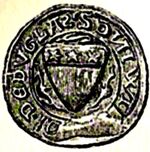
Seal of William Douglas the Hardy
During the Wars of Scottish Independence, Sir William Douglas the Hardy, Lord of Douglas was governor of Berwick-upon-Tweed when the town and Berwick Castle were besieged by the forces of Edward I of England. Douglas was captured and was released only after he had agreed to accept the claim of the English king to be overlord of Scotland. He subsequently joined William Wallace in fighting for Scottish independence, but was captured and taken to England, where he died in 1298, a prisoner in the Tower of London.[2]
The "Good" Sir James Douglas or "Black Douglas"[]
William Le Hardi's son, James Douglas, "The Good Sir James", was the first to take the epithet "Black". Douglas was set to share in Bruce's early misfortunes, being present at the defeats at Methven and Dalrigh. But for both men these setbacks were to provide a valuable lesson in tactics: limitations in both resources and equipment meant that the Scots would always be at a disadvantage in conventional Medieval warfare. By the time the war was renewed in the spring of 1307 they had learnt the value of guerrilla warfare – known at the time as 'secret war' – using fast moving, lightly equipped and agile forces to maximum effect against an enemy often locked in to static defensive positions.[3] Sir James Douglas recaptured Roxburgh Castle from the English in 1313. Sir James Douglas was made a knight banneret, a high honor, on the field and commanded a wing of the army at the Battle of Bannockburn in 1314.[2][3]
James was called "The Black Douglas"[6][7] by the English for his dark deeds in English eyes, becoming the Bogeyman of a Northern English lullaby "Hush ye, hush ye, little pet ye. Hush ye, hush ye, do not fret ye. The Black Douglas shall not get ye." There are also unsubstantiated theories that this was because of his colouring and complexion, this is tenuous, Douglas only appears in English record as "The Black", in Scots' chronicles he is almost always referred to as "The Guid" or "The Good". Later Douglas Lords took the moniker of their revered forebear in the same way that they attached Bruce's Heart to their Coat of Arms, to strike fear into the hearts of their enemies and exhibit the prowess of their race.[2][3]
Crusader[]

Morton Castle Today
King Robert the Bruce had requested that Douglas, latterly his most esteemed companion in arms, should carry his heart to the Holy Land, as atonement for the murder of John III Comyn. Douglas and his knights had been invited to join the forces of Alfonso XI of Castile, Edward of England's cousin by Queen Isabella, mother of King Edward III of England to fight a Crusade against the Moors in 1330 at the Castle of the Stars at Teba. Douglas was killed as he led a cavalry charge against the enemy while outnumbered and cut off from the main Christian force; Alfonso kept his army back from the attack; likely in some arrangement with his cousin Edward who could never beat the Douglas in combat. The casket containing the heart of the Bruce was recovered and returned to Scotland, to be interred at Melrose Abbey. Douglas' bones were boiled and returned to Scotland; his embalmed heart was recently recovered in the Douglas vaults at the Kirk of St Bride but his bones are not in the stone vault lying under his effigy and they have yet to be located.[2]
Sir Archibald Douglas, Guardian of the Realm[]

Lennoxlove House, a seat of the Marquess of Douglas
The Scottish army that fought and lost the Battle of Halidon Hill in 1333 was led by James' youngest brother who had been elected Regent of Scotland in late March of 1333. Sir Archibald Douglas has been badly treated by some historians; frequently misidentifying this Douglas warrior as the Tyneman or loser when the moniker was intended for a later less fortunate but equally warlike Archibald. He was mentioned in Barbour's The Brus for his great victory during the Weardale Campaign; leading the Scottish army further south into County Durham he devastated the lands and took much booty from Darlington and other nearby towns and villages.[3]
Sir James 'The Good' Douglas' natural son William succeeded to the title as Lord of Douglas but may not have completed his title to the estates, possibly because he might have been underage. He died at Battle of Halidon Hill with his uncle, Sir Archibald Douglas. James' younger brother, Hugh the Dull, Lord of Douglas, a Canon serving the See of Glasgow and held a Prebendary at Roxburgh became Lord Douglas in 1342; Hugh of Douglas resigned his title to his nephew, the youngest surviving son of the Regent Archibald, William Lord of Douglas who was to become the first Earl. The First Earl's legitimate son James Douglas, 2nd Earl of Douglas succeeded him. His illegitimate son by Margaret Stewart, 4th Countess of Angus was George Douglas, 1st Earl of Angus, who was the progenitor of the Earls of Angus also known as the "Red Douglases".[2]
The prestige of the family was greatly increased when James Douglas's great nephew, James Douglas, 2nd Earl of Douglas married a House of Stuart princess. In 1388 at the Battle of Otterburn he was instrumental to the Scots' victory, but was killed during the fighting. Leaving no legitimate heir, his titles passed to the illegitimate son of his great uncle.[2]
15th Century[]
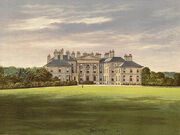
Dalkeith one of the Douglas seats
Wars with England[]
Archibald Douglas, 3rd Earl of Douglas did much to consolidate the family's power and influence. He successfully defended Edinburgh Castle against Henry IV of England in 1400 but died the following year.[3]
His son, Archibald Douglas, 4th Earl of Douglas, married the daughter of Robert III of Scotland. The fourth Earl fought against King Henry IV of England at the Battle of Shrewsbury in 1403, where he was taken prisoner. He became a general in Joan of Arc's army and continued the fight against the English. He was rewarded for his efforts with the Duchy of Touraine.[2]
In 1406, with the death of the king, the 4th Earl of Douglas became one of the council of regents to rule Scotland during the childhood of James I of Scotland. In 1412 the 4th Earl had visited Paris, when he entered into a personal alliance with John the Fearless, Duke of Burgundy, and in 1423 he commanded a contingent of 10,000 Scots sent to the aid of Charles VII of France against the English. He was made lieutenant-general in the French army, and received the title Duke of Touraine, with remainder to his heirs-male, on 19 April 1424. The newly created French duke was defeated and slain at Battle of Verneuil on 17 August 1424, along with his second son, James, and son-in-law John Stewart, 2nd Earl of Buchan.[2][3]
Murder of the Douglas chiefs at Edinburgh Castle[]
The Douglases became so powerful that by the early fifteenth century they were seen as a threat to the stability of the nation. In 1440 the young William Douglas, 6th Earl of Douglas and his brother were invited to dine with the ten year-old King James II of Scotland. The dinner was organised by Sir William Crichton of Clan Crichton. Known as the Black Bull Dinner, a black bull's head, the symbol of death, was brought in. After the dinner the Douglas chiefs were dragged out to Castle Hill, given a mock trial and beheaded. The Clan Douglas then laid siege to Edinburgh Castle. Crichton perceiving the danger surrendered the castle to the King and was raised to the title of Lord Crichton. It is still unclear exactly who else was ultimately responsible, though it is thought Crichton, Livingstone and Buchan as likely candidates.[2][3]
Clan Conflicts[]
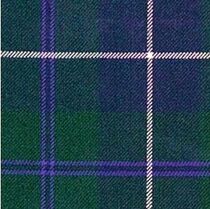
The tartan of Clan Douglas (not the Black Douglases)
In 1448 Hugh Douglas, Earl of Ormond held command along with John Wallace of Clan Wallace when he led a Scottish force to victory against an English army at the Battle of Sark in 1448.
The king gave the Earl of Atholl's confiscated lands of Strathbogie to Clan Gordon. The castle there became known as Huntly, a reminder of the Gordons' Berwickshire lands. Sir Alexander Gordon was created Earl of Huntly in 1449. At this time the king was at enmity with the powerful Clan Douglas. The Gordons stood on the king's side, and with their men involved in the south of the country. The Earl of Moray was a relation and ally of the Douglases. He and the Douglases took the opportunity to sack the Gordon lands, setting Huntly Castle ablaze. However the Gordons returned and quickly destroyed their enemies. Although the castle was burned to the ground, a grander castle was built in its place.
The Douglases had a long feud with Clan Colville. Sir Richard Colville had killed the Laird of Auchinleck who was an ally of the Douglases. To avenge this murder the Douglases attacked the Colvilles in their castle, where many were killed. The Douglases levelled the Colville's castle and put their men to the sword. William Douglas, 8th Earl of Douglas personally executed Richard Colville.
Murder of the Douglas chiefs at Stirling Castle[]
The strength of the Douglases made it impossible for James II of Scotland to rule freely. After fruitless feuding with the Douglases the King invited William Douglas, 8th Earl of Douglas to Stirling Castle in 1452 under the promise of safe conduct, but then the King accused the Earl of conspiracy in his dealings with the Yorkists in England and through a pact made between Douglas, the Earl of Crawford and the Lord of the Isles. Upon Douglas' refusal to repudiate the pact and reaffirm his loyalty to James II, the King drew his dagger and stabbed Douglas in the throat. The story goes that the King's Captain of the Guard then finished off the Earl with a pole axe. The body was thrown from the window into a garden below, where it was later given burial. A stained glass window bearing the Douglas Arms now overlooks "Douglas Garden", the spot where the Earl is said to have fallen.[2]
Feud with the Stewart royal family[]
In 1455 James Douglas, 9th Earl of Douglas rebelled against the king but his forces were defeated at the Battle of Arkinholm by the king's forces who were commanded by the Red Douglas, Earl of Angus. This brought an end to the Black Douglases.[2] After the battle an act of parliament gave the Earl of Angus the lordship of Douglas with the original possessions of his ancestors in Douglasdale. The 9th earl was later defeated by the forces of King James III of Scotland at the Battle of Lochmaben Fair in 1484.[8][9][10]
16th Century Conflicts[]
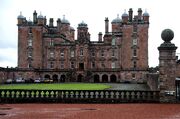
Drumlanrig Palace one of the Douglas seats
In 1513, there was a strong Douglas contingent at the Battle of Flodden Field, where two of Archibald Douglas, 5th Earl of Angus's (Red Douglas's) sons were killed along with 200 men of the Clan Douglas.[2]
A dispute occurred in 1530, when Sir Robert Charteris, the 8th Laird and chief of Clan Charteris fought a duel with Sir James Douglas of Drumlanrig in what was said to have been one of the last great chivalric contests. It was fought with all the observance of a medieval tournament with heralds and the king himself watching from the castle walls. The joust was apparently fought with such fury that Charteris' sword was broken and the king had to send his men-at-arms to part the combatants.
Archibald Douglas, 6th Earl of Angus held the post of Lord Chancellor and became guardian of James V of Scotland by marrying his widowed mother, Margaret Tudor, with whom he had a daughter, Margaret Douglas, mother of Henry Stuart, Lord Darnley. In 1545, Angus led his forces to victory at the Battle of Ancrum Moor where they defeated the English army during the Rough Wooing, and he was also present at the defeat in 1547 at the Battle of Pinkie Cleugh.[2]
James Douglas, 4th Earl of Morton, nephew of the 6th Earl of Angus, was a bitter enemy of Mary, Queen of Scots. He was one of the murderers of the queen's secretary David Rizzio and was heavily implicated in the murder of her second husband Lord Darnley. As regent, he was brutal in crushing factions still loyal to Mary, however, he was accused of complicity in the murder of Darnley and was executed in 1581.[2][3]
17th century & the Civil War[]

Hermitage Castle
During the Wars of the Three Kingdoms, William Douglas, 11th Earl of Angus, a Catholic, was a supporter of Charles I of Scotland. In 1633, he was created Marquess of Douglas. Following the Battle of Kilsyth in 1645, he joined James Graham, 1st Marquess of Montrose, and was present when Royalist forces fought Covenanter cavalry at the Battle of Philiphaugh where he barely escaped with his life. Following Cromwell's victory, he was able to make peace and was fined £1,000.[3]
In 1660, William Douglas, the brother of the second Marquess of Douglas became, through marriage, the Duke of Hamilton. Eventually, the titles of Marquess of Douglas, Earl of Angus, and several others devolved to the Dukes of Hamilton and the heir of that house is always styled 'Marquess of Douglas and Clydesdale'. The Douglas and Hamilton lines became Douglas-Hamilton and, under Scots law, are barred from inheriting the title of chief of Clan Douglas due to the hyphenated surname. This similarly applies to the Douglas-Home family who joined their surnames in the eighteenth century.
In 1689, James Douglas, Earl of Angus raised the Cameronian regiment (Earl of Angus's regiment) Although greatly outnumbered, the regiment managed to defeat a larger Jacobite force at the Battle of Dunkeld. The regiment was victorious under the command of Captain George Munro of Auchinbowie.[11]
18th century & the Jacobite risings[]
In 1703 the Marquisate of Douglas was elevated to a Dukedom, however, in the 17th century, leadership of the family passed to the Douglases of Drumlanrig, in Dumfrieshire who are also descended from the Black Douglases. The Douglases of Drumlanrig had become Earl of Queensberry in 1633, Marquises in 1682 and Dukes in 1684. The manoeuvers of James Douglas, the second Duke of Queensberry, contributed to the Union of 1707.[3] Later in the 18th century, during the Jacobite Uprisings, the Clan Douglas continued their support for the British government.
Chieftancy[]
His Grace Angus Douglas-Hamilton, the 15th Duke of Hamilton and 12th Duke of Brandon is heir to the chiefdom of the house of Douglas, but he cannot assume the title of chief since the Lord Lyon King of Arms requires him to assume the single name Douglas.[1] Note that the Duke of Hamilton is the Chief of Clan Hamilton. On His Grace's agreeing to adopting the single name 'Douglas' for his surname, the clan will become again non-Armegirous registered with The Lord Lyon King of Arms. For a list of the historic chiefs of Clan Douglas see: Earl of Douglas, until 1455 and Earl of Angus for after 1455.
Douglas castles[]

Aberdour Castle

Douglass tartan, as published in 1842 in the Vestiarium Scoticum. Whether the Douglasses wore tartan in the sixteenth century, as the Vestiarium asserts, can be questioned.[12]
- Aberdour Castle, Fife, held by the Earls of Morton (partially preserved).
- Balvenie Castle, Moray, held by James Douglas, 7th Earl of Douglas (ruined).
- Berwick Castle, Northumberland. Governed by William "le Hardi".(ruined, now forms part of Berwick-upon-Tweed train station)
- Bothwell Castle, South Lanarkshire (ruins).
- Bowhill House, Selkirkshire. Home of the Duke of Buccleuch and Queensberry (preserved).
- Dalkeith Castle, Mid-Lothian. (heavily converted)
- Douglas Castle in South Lanarkshire (now only minimal ruins remain).
- Drumlanrig Castle, Dumfries and Galloway. 17th century mansion house of the Dukes of Buccleuch and Queensberry (preserved).
- Grangemuir House, Fife
- Hermitage Castle, Roxburghshire, 13th century Douglas stronghold (restored ruin).
- Hume Castle, Berwickshire. ancient links with Douglas, home of Sir Alexander Douglas.
- Kilspindie Castle, East Lothian. Home to the Douglases of Kilspindie, (scant ruins)
- Lennoxlove House, East Lothian. Home of the Duke of Hamilton, (also the Marquess of Douglas and Clydesdale, Earl of Angus etc.) (preserved).
- Loch Leven Castle, Kinross. First home of the Earl of Morton (ruins).
- Lochindorb Castle, Strathspey
- Morton Castle, Nithsdale, Dumfries and Galloway. ruined former home of the Douglas Earls of Morton.
- Newark Castle, Selkirkshire
- Ormond Castle, Black Isle
- Roxburgh Castle, captured by Sir James Douglas.
- Sandilands Castle, Fife (ruins).
- Strathaven Castle, South Lanarkshire
- Strathendry Castle, Fife
- Tantallon Castle, East Lothian. Stronghold of the Red Douglases (partially ruined).
- Threave Castle, Dumfries and Galloway (ruins).
- Timpendean Tower, Roxburghshire (ruins).
Clan septs[]
- Agnew
- Alexander
- Blackwood
- Blackett
- Blacklock
- Blalock
- Breckinridge
- Brown
- Brownlee
- Cavin
- Cavers
- Dickey
- Dickle
- Dick
- Drysdale
- Drongan
- Foster
- Glenn
- Glendinning
- Glenndinning
- Hardy/Hardie
- Henry
- Hixson
- Inglis
- Kidston
- Kilgore
- Kilpatrick
- Kirk
- Kirkland
- Kirkpatrick
- Lockerbie
- Lockerby
- Lockery
- Lochrie
- MacGuffey
- McKittrick
- Morton
- Sandlin
- Sandiland
- Soule
- Sterrett
- Symington
- Young
Immigrants to North America[]
- William Douglas (1610-1682) - Immigrated 1640
Popular culture[]
In the Highlander novel Scotland the Brave, James Douglas is a fictional Scot born into Clan Douglas and died his First Death in 1746 at the Battle of Culloden.
The Douglas tartan was worn by the former British Army Regiment, The Cameronians (Scottish Rifles) and is still worn by the Royal Gurkha Rifles

Scottish Clan Map
See also[]
- Armigerous clan
- British Royal Family
- Clan Wallace (ally)
- Line of succession to the British throne
- de facto ruler of Scotland
- Members of the House of Douglas
References[]
- ^ a b The Standing Council of Scottish Chiefs
- ^ a b c d e f g h i j k l m n o p q r "The Douglases". By Jim Hewitson. 1997. ISBN 1852170662.
- ^ a b c d e f g h i j k Oxford Companion to Scottish History, p. 172 – 176, edited by Michael Lynch, Oxford University Press. ISBN 9780199234820.
- ^ The Kingdom of the Scots, p.329
- ^ The Surnames of Scotland
- ^ Barbour, John. The Bruce. I, lines 29, 381-406;XV, lines 537-38
- ^ Brown, Michael, The Black Douglases-War and Lordship in late medieval Scotland, Chap. 1. p19
- ^ http://www.hostkingdom.net/scot.html
- ^ Drysdale/Douglas Family History
- ^ Langholm Online A History of the Border Reivers
- ^ "The Monros of Auchinbowie" and Cognate Families by John Alexander Inglis. Edinburugh, Privately printed by T and A Constable. Printers to His Majesty. 1911.
- ^ Scotland's Forged Tartans, p.51
Sources[]
- Fraser, Sir William. (1885). The Douglas Book
- Coventry, Martin The Castles of Scotland (3rd Edition), Goblinshead, 2001
- Anderson, William The Scottish Nation Or the Surnames, Families, Literature, Honours and Biographical History of The People of Scotland 1863
- Barrow, G W S. The Kingdom of the Scots: Government, Church and Society from the eleventh to the fourteenth century. New York: St. Martin's Press, 1973.
- Black, George Fraser. The Surnames of Scotland.
- Brown, Michael. "The Black Douglases"
- Stewart, Donald C. & Thompson, J Charles. Scotland's Forged Tartans, An analytical study of the Vestiarium Scoticum. Edinburgh: Paul Harris Publishing, 1980. ISBN 0-894595-67-7
External links[]
- Clan Douglas Society of North America
- Douglas Family Site, Brief Historical Account
- Douglas History The Douglas Archives - a compendium of historical notes and biographies.
| |||||||||||
| This page uses content from the English language Wikipedia. The original content was at Clan Douglas. The list of authors can be seen in the page history. As with this Familypedia wiki, the content of Wikipedia is available under the Creative Commons License. |

